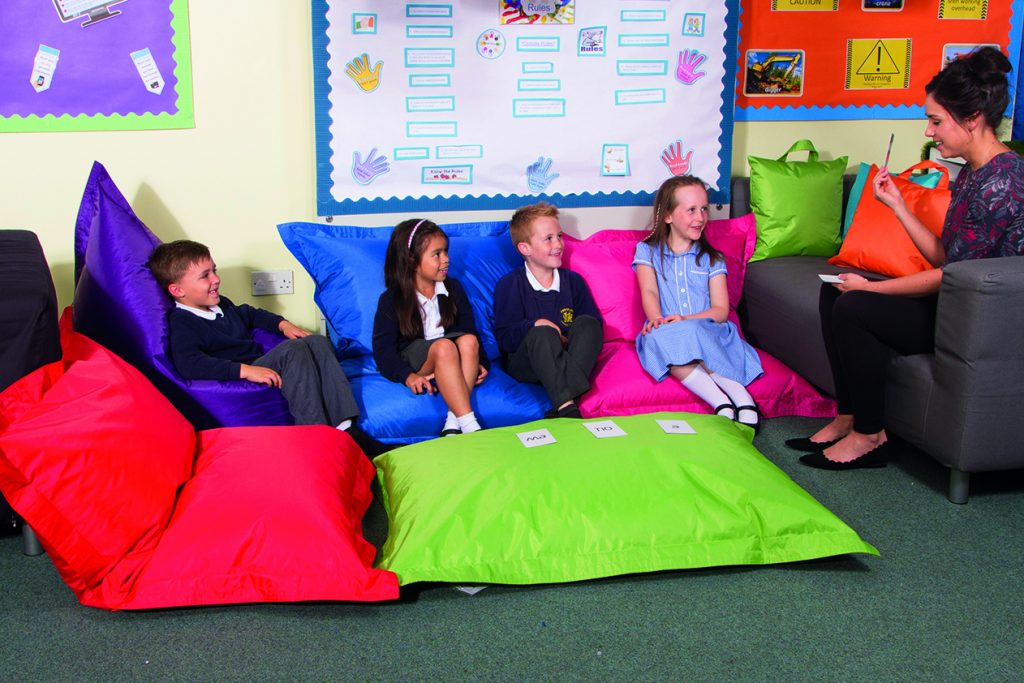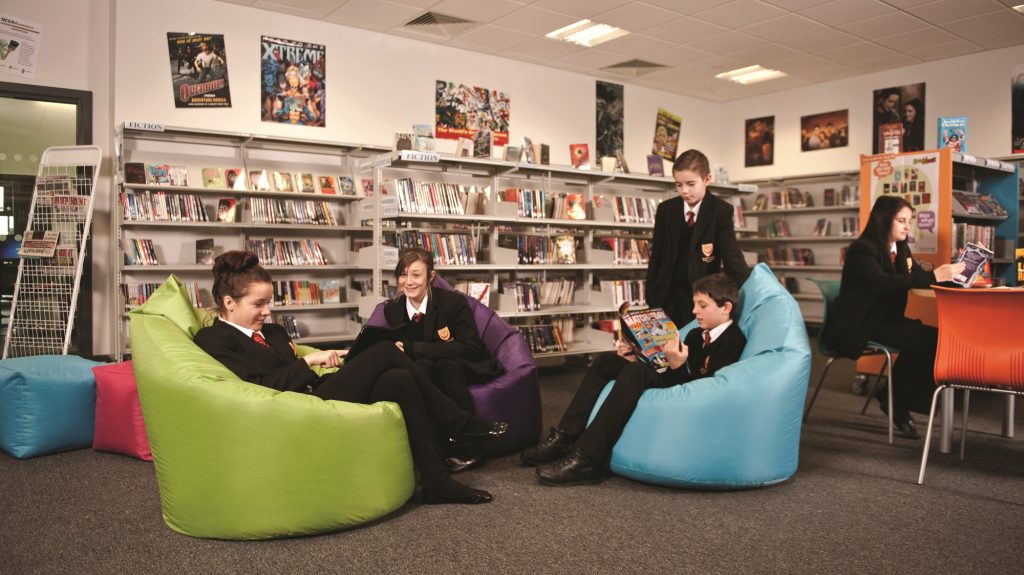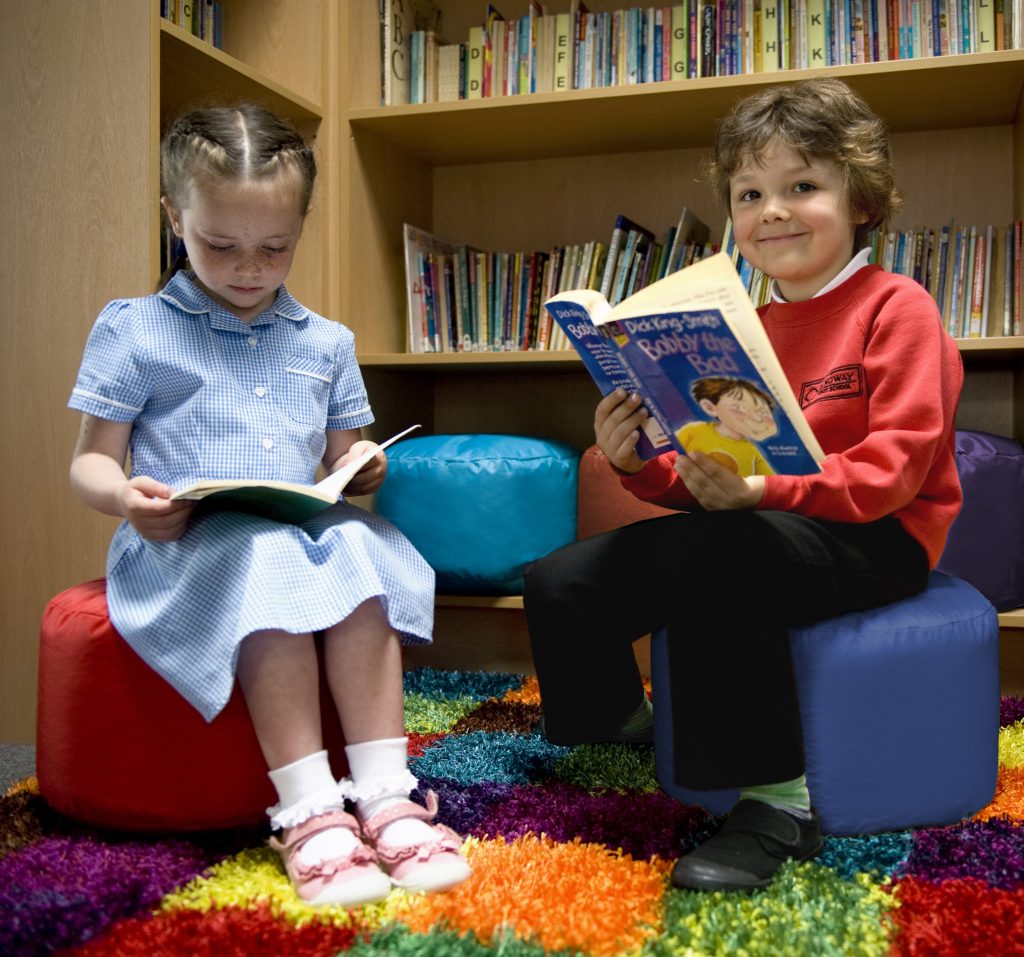Are bean bags the shape of things to come in Primary School education?
In a recently published report by educational supplier Eden Learning Spaces, a perhaps surprising form of soft-seating – ‘bean bags’ – has been proven to greatly enhance the learning environment in primary schools – and within SEN too. But could bean bags really be an important addition to improve learning and understanding for primary school pupils?

The report has taken a fresh perspective to educational furnishings. Listening to up-to-date research findings and drawing upon their own extensive experience in product design has led to their development of cross-curricular soft seating, custom-designed for the education sector. Case studies have shown that bean bag seating can indeed be highly beneficial to enhancing the learning experience within a classroom, as well as outdoor learning environments.
So how do bean bags actually aid learning? And is this opportunity to boost children’s knowledge and understanding limited to specific subjects, or does it extend right across the curriculum? Here’s what the report had to say:
Ergonomics and aesthetics for education

In 2012, a study on classroom design conducted by the University of Salford concluded that learning environments can affect a child’s academic progress by as much as 25% over a year. And with almost half of all five-year-olds lacking the basic skills when they start school [i], that’s a huge – and challenging –undertaking which necessitates teachers requiring the best resources possible.
It has also been proven that design and ergonomics play a huge part in a learner’s concentration span and efficiency levels. Discomfort for students is a distraction to learning. So instead of wriggling around on uncomfortable seating, students can snuggle down into an ergonomically-designed bean bag that instantly becomes customised as it naturally moulds to the shape of the individual child’s body. The polystyrene bead filling inside the bean bags gives optimum comfort and support as well as allowing the learner to remain fully focussed on the task at hand.
Reading becomes an experience
 Using bean bags to encourage and enhance reading amongst children is already proving a great success in many schools. As a motivational tool, bean bags can work well in a library or reading corner (and can also allow a ‘pop-up’ reading area where space is restricted) instantly modernising a traditional environment.
Using bean bags to encourage and enhance reading amongst children is already proving a great success in many schools. As a motivational tool, bean bags can work well in a library or reading corner (and can also allow a ‘pop-up’ reading area where space is restricted) instantly modernising a traditional environment.
One school in Beccles, Suffolk uses bean bag furniture in their library, and every break time students can be found snuggled up and engrossed in a book. ‘They have worked particularly well as they provide a comfortable and inviting place to browse for those students who are less motivated readers,’ said Laura Ballantyne, the school’s Subject Leader for Literacy.
Given that learning to read and a love of reading is fundamental to education, a survey by the National Literacy Trust (2012) revealed some unexpected and worrying insights. The research found that one in five children aged eight to 16 years old were ‘embarrassed’ to be seen reading. As a result, changing children’s perspective on reading and increasing literacy standards are at the forefront of the government’s education strategy, as detailed in the new National Curriculum.
Former Secretary of State for Education Michael Gove, whilst in office, said: ‘A solid foundation in reading is crucial to a child’s success as they progress through primary school, into secondary school and then in later life’. So making the whole reading experience more fun and enjoyable – and ultimately getting better results – is a must for both the pupil and teacher alike.
Hi-tech applications
But bean bags’ classroom application is not restricted to the cosy, comfortable image of curling up with a library book – ‘bean bag learning’ is being used right across the curriculum too.
With the rapid growth in the use of tablet devices in primary schools, ICT is probably the fastest growing subject accounting for a huge annual spend in schools’ budgets. In a statement from the British Educational Suppliers Association made in 2013, they estimated that UK schools will spend £596 million on ICT resources in 2014-2015, an annual increase of £40million. They further estimated that almost a quarter of a million tablet devices will be in use in primary schools by the end of 2015.
To match the additional technology and allow ICT to be taught in a flexible learning environment, Eden Learning Spaces has specifically designed a state of the art bean-filled reading chair which has substantial back and neck support for users. The design of this high-backed reading bean bag chair really improves both comfort and concentration whilst the learner is using a technical device.
‘The size and shape of the high-back bean bags are more supportive than a classic shaped bean bag which is great for our students as it helps them to feel more relaxed and allows them to concentrate,’ said the Media Co-ordinator of Longford Park School.
No room – no problem
The lightweight mobility of bean bag furniture means that they can also be easily transported (by pupils as well as staff) when an impromptu learning space is needed. Whether it’s for a few learners needing to do some quiet reading – as some schools don’t have a dedicated library – a virtual library can be created effortlessly with the bean bags in perhaps a corridor area. And with the ever increasing ‘bulging classrooms’ problem a ‘pop-up’ class can quickly be established in the corner of a room, a reception area – in fact anywhere that has available floor-space for the bean bags.
Thinking outside the four walls
But bean bag applications aren’t just limited to use within the classroom. Since the launch of the ‘Learning Outside the Classroom Manifesto’ in 2006, there has been considerable focus on developing and raising standards for outdoor learning resources and activities.
With that in mind, Eden Learning Space explored outdoor learning via focus groups and interviews with teaching professionals to determine how products could add value. Findings showed that: products that could be used equally well both indoors and outside were preferred; having an outdoor seat was a useful tool in focusing learners and keeping them grouped together; being waterproof, durable and easily maintained and stored were key features too.
As almost 90% of their entire bean bag range is waterproof, the opportunities for outdoor learning applications are endless. The full range includes a wide spectrum of colours as well as animal and other prints and a huge variety of shapes. (Bean bags are not just traditional round shapes anymore!)
So for us at Learning Rooms, the bean bags have ticked all the boxes. They are already rated highly by many primary school users and those within the SEN sector too. Here are a couple of comments:
‘The variety of colours allows children individual choice and they are used regularly for reading and as part of their own imaginative play activities. The quality and texture of the material of the bean bags makes them a really versatile product, they have also been used in outdoor classroom activities.’ Hazel Scott, Head Teacher, Ringway First School.
‘We are looking forward to using them outside to form a soft area in our new playground and have with games teaching pupils different colours and to enjoy being active with play. People with Autism experience the world from a very different sensory perspective. The stability provided by a bean bag seat is ideal for supporting proprioceptive vestibular senses. Everything experienced is accentuated, and the deep pressure provided by a giant bean bag helps to keep people calm.’ Kerrie Highcock, Assessment & Training Coordinator, North East Autism Society.
The Eden Learning Spaces vision is for educational bean bag products to be considered fundamental for modern learning in UK education.
Here at Learning Rooms, we think bean bags could indeed be the shape of things to come in your Learning Room environment. You can purchase the Eden Learning Spaces bean bags from Learning Rooms partner GLS or read more about Eden Learning Spaces bean bags by clicking onto www.edenlearningspaces.co.uk
‘The highest ranked attributes of a quality resource in primary education are reliability, consistency and durability.’ – Classroom Learning Resources, BESA, 2013
[i] Source: Marmot Report published September 2014. (Professor Marmot, University College London.)

